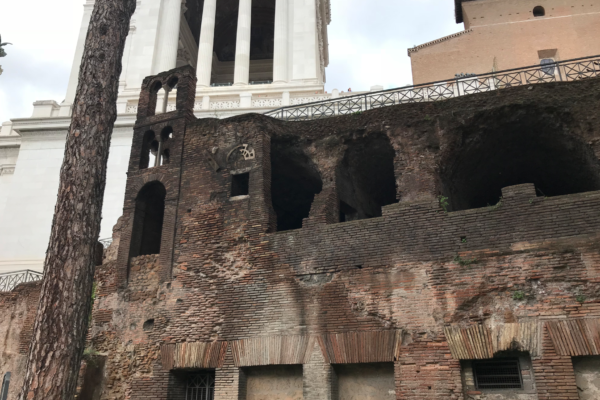Start with our video overview:
The Capitoline Insula, a Roman apartment structure dating back to the 2nd century CE, is located on Rome’s Capitoline Hill, one of the most prominent and prestigious locations in ancient Rome. The building is situated near the Basilica of Santa Maria in AraCoeli and is easily visible to visitors today (with limited accessibility). .
The word insula (plural: insulae) means Island in Latin; the word has been used to describe the multi-level apartment residences of the Roman era because they rose like islands from the architectural landscape of the city. Insulae were scattered across the city, the largest among them having 10 or more floors, reaching a height of 20-25 meters. Most insulae that have survived remain in partial condition, serving as foundations for later buildings. The Capitoline Insula is an exception, regarded as the best-preserved example of the construction style, providing important insights into the daily lives and social systems of ancient Roman society, as few Romans could afford to own houses, with the majority residing in insulae. It was preserved by serving as the foundation for the Church of S. Rita da Cascia, later demolished for the Vittoriano monument construction. Its Romanesque bell tower and frescoes remain.
The Capitoline Insula, also known as the Insula dell’Ara Coeli, is made up of five floors, whose ceiling heights diminish with succeeding floors. Scholars assert that artisans from different socioeconomic classes lived in these apartments, such as tanners, merchants, and possibly even members of the imperial household. The unique construction of the Capitoline (Ara Coeli) Insula was exposed due to excavations and restorations of the area in the context of the construction. It was built using a combination of brick and concrete, with the missing highest levels built from wood.
Insulae served as both residential areas and centers for trade and industry. Shops and small businesses were housed in the row of rooms that opened onto the streets, which were 30 feet below the level of today’s modern streets, while rich residents occupied the first floor. The higher the level, the smaller the living area, indicating that the inhabitants of the top level were most likely the poorest.
Juvenal, also known as Decimus Iunius Iuvenalis, a Roman poet and satirist, listed the possessions that one poor insulae resident lost in a fire, including a small bed, an old chest of drawers, six cups, a flagon, and a statue.
The Capitoline Insula now appears isolated, though there used to be a series of insulae that surrounded the Capitoline Hill during antiquity. These insulae were destroyed when Mussolini built the Via del Teatro di Marcello, a part of his Via del Mare project. The remaining insula is only five levels.
Insulae were a very important component of Roman urbanism and played a significant part in establishing the city’s social and economic landscape.
Bibliography
- Juvenal, “The Satires”, Satire III, Fleeing Rome
- Carandini, 1982, “Le Insulae romane: case e società”
- Richardson Jr.,1992, “The Roman Insulae: Living and Working in the City”
- Aldrete and A. Faudree, 2004, “The Capitoline Insula: Residential Revolutions in Imperial Rome”
- C. J. Putnam, 2005, “The Capitoline Hill in Ancient Rome”
- Santangeli Valenzani, 2005, “L’Insula dell’Ara Coeli: storia, architettura e funzioni abitative”
- Glenn R. Storey, 2006, The “Skyscrapers” of the Ancient Roman World
- Pierini, 2015, “Il Campidoglio e l’area archeologica dell’Insula dell’Ara Coeli”
Explore further:
This content is brought to you by The American Institute for Roman Culture, a 501(C)3 US Non-Profit Organization.
Please support our mission to aid learning and understanding of ancient Rome through free-to-access content by donating today.
Cite This Page
Cite this page as: Darius Arya, The American Institute for Roman Culture, “Insula Capitolinus (Capitoline Insula)” Ancient Rome Live. Last modified 06/26/2020. https://ancientromelive.org/insula-capitolinus-capitoline-insula/
License
Created by The American Institute of Roman Culture, published on 10/24/2019 under the following license: Creative Commons: Attribution-NonCommercial-ShareAlike. This license lets others remix, tweak, and build upon this content non-commercially, as long as they credit the author and license their new creations under the identical terms. Please note that content linked from this page may have different licensing terms.





